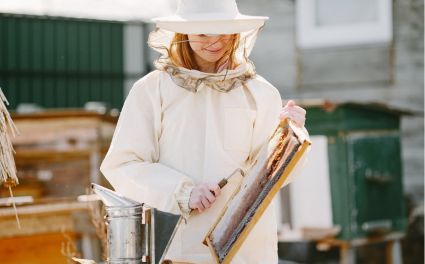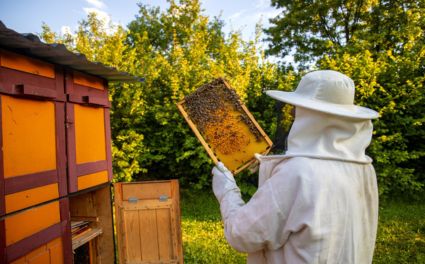Did you know it takes around 12 worker bees their entire lives to produce just one teaspoon of honey? This fact alone shows how extraordinary honey bees are. Their ability to turn delicate flower nectar into the golden, energy-rich food we love is one of nature’s most remarkable processes.
In this guide, we’ll take a closer look at how bees collect honey, from their foraging flights to the final honey storage in the hive. Along the way, you’ll also learn how modern beekeeping equipment — like beekeeping jackets, beekeeping suits, and beekeeping gloves — plays a crucial role in keeping both beekeepers and colonies safe.
🌸 Foraging for Nectar
Worker Bees as Foragers
In every colony, worker bees are responsible for collecting nectar, pollen, and water. Once they reach maturity (around three weeks old), they become expert foragers, flying miles each day in search of blooming flowers. Their navigation skills are exceptional — bees can return to the same flower patch using the sun’s position and even communicate directions through a “waggle dance.”
Selecting the Right Flowers
Bees are selective about which flowers they visit. They’re attracted by bright colors, strong scents, and nectar that’s easy to reach. Interestingly, bees can see ultraviolet light — patterns invisible to humans — helping them locate the most nectar-rich blooms.
Collecting Nectar
Using their long tongue (called a proboscis), bees draw nectar from flowers and store it in their “honey stomach.” On the way back to the hive, enzymes begin breaking down the nectar’s sugars. When they return, foragers share this enzyme-rich nectar with other worker bees, who continue the transformation process inside the hive.

🍯 Nectar to Honey Transformation
The Sharing Process
Inside the hive, the forager passes the nectar to house bees through a process called trophallaxis. This mouth-to-mouth exchange mixes the nectar with enzymes that start breaking down sucrose into simpler sugars — mainly glucose and fructose.
Enzymatic Conversion
The enzymes — especially invertase and glucose oxidase — play a crucial role. They not only convert sugars but also reduce the nectar’s pH, making it more acidic and resistant to bacteria. This biological process helps ensure that honey remains fresh for months or even years.
Water Reduction
The nectar initially contains about 70–80% water. Worker bees spread it in thin layers across the wax comb and fan their wings to evaporate moisture. As water content drops to around 17–18%, the thickened nectar officially becomes honey. Bees then seal the comb cells with a thin layer of wax — a process called capping — to preserve it for future use.
🧱 Honeycomb Construction
The honeycomb is one of nature’s most efficient structures. Worker bees produce wax from glands on their abdomen after consuming honey. They mold the wax into perfect hexagonal cells — a shape that maximizes storage space while minimizing material use.
Inside these hexagonal cells, nectar undergoes its final transformation into honey. Bees maintain the hive’s internal temperature at around 35°C using their wings to ventilate, which helps speed up the drying process.
During this delicate work, beekeepers who inspect hives rely on protective clothing such as breathable beekeeping veils and flexible beekeeping trousers to avoid stings while ensuring hive comfort remains undisturbed.
🧵 Ripening and Capping
Monitoring Moisture Levels
Bees monitor honey moisture carefully. Once the water content drops to a stable level, they cap the cells with wax. This capping process prevents air and moisture from spoiling the honey, allowing it to stay fresh for long periods — even through harsh winters.
Signs of Honey Readiness
Beekeepers look for capped combs when deciding if honey is ready for harvest. Modern beekeeping suits such as those offered by Oz Armour protect keepers during this crucial step, ensuring comfort while working around large colonies.
Also read: How Does Bee Pollination Work?
🏺 Storage and Utilization
The Colony’s Food Bank
Stored honey is the primary food source for bees, providing essential carbohydrates and nutrients during cold or nectar-scarce months. Bees consume it to maintain energy for heating the hive, feeding brood, and performing daily activities.
Winter Survival
During winter, bees form a “cluster” around their queen, vibrating their wings to generate heat. They consume stored honey gradually, ensuring survival until spring blooms return. A well-stocked hive is critical — one reason why ethical beekeepers always leave plenty of honey behind for their colonies.
Beekeepers can explore high-quality beekeeping kids suits for educational programs or family beekeeping — helping young learners experience this fascinating process safely.
🧤 Beekeeping Gear and Safety
Honey collection is one of the most rewarding parts of beekeeping, but it also requires proper protection. Professional beekeepers rely on full-body beekeeping jackets, ventilated suits, and ankle protection gears to avoid stings while working near active colonies.
Companies like Oz Armour are known globally for their ventilated suits, premium gloves, and pink bee suits that combine comfort, durability, and maximum protection. While many beekeepers wonder “do bee suits protect from wasps?” — studies and real-world experience show that high-quality suits can significantly reduce sting risk from both bees and wasps when used properly.
🧠 Learning More About Bees
Understanding how honey bees work is key to becoming a successful beekeeper. Beginners can explore educational content through Oz Armour’s Learn Beekeeping section — featuring detailed guides on bee behavior, hive management, and safety practices.
You can also read more blogs about beekeeping to discover fascinating topics like:
Each article deepens your understanding of topics such as bumblebee vs honeybee, bee nest differences, and removing a bee sting safely.
🐝 The Role of Beekeeping Equipment
Quality beekeeping equipments — from hive tools to extractors — ensures efficiency and safety when handling honey. Accessories like smokers, uncapping knives, and frame grips help maintain calm colonies and improve productivity.
Beekeepers who invest in durable tools and reliable protective clothing often see smoother honey harvesting experiences and healthier hives overall.

🌼 Final Thoughts
The transformation of flower nectar into honey is an extraordinary example of teamwork, biology, and precision. From foraging flights to comb construction and capping, every step reflects the complex intelligence of honey bees.
For beekeepers, observing this process up close is both educational and inspiring. With the right knowledge, dedication, and protective gear from trusted brands like Oz Armour, the experience becomes safer and more rewarding.
Whether you’re a beginner exploring Learn Beekeeping, a seasoned apiarist refining your honey collection techniques, or simply someone fascinated by the lives of bees, understanding their honey-making journey deepens your respect for nature’s most skilled workers.



